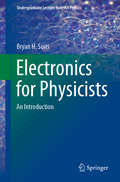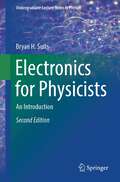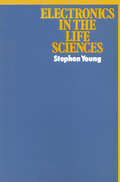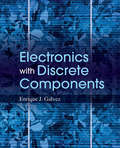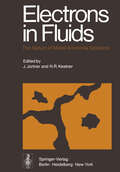- Table View
- List View
Electronics and Industrial Policy: The case of computer controlled lathes (World Industry Studies #5)
by Staffan JacobssonThere is a rapidly expanding literature on the economics of the so called 'new technologies' - especially on those using microelectronic systems. Dr. Jacobsson's book deals with microelectronics-based innovation in machine tools: with the production and use of computer numerically controlled machine tools in the world economy and especially in the Third World. Jacobsson is mainly interested in the implications which CNC machine tools may be expected to have for users and producers in the Newly Industrialising Countries. He approaches this as a problem in applied economics and the book will have a primary interest for those economists whose concern is with the problems of industrialisation in developing countries. It will be parti cularly valuable to those who are preoccupied with the role of local capital goods manufacture and with the technological preconditions for this kind of production. Jacobsson is able to give detailed and specific arguments on these matters as far as CNC machine tools are concerned. In my view, the book has a considerably wider interest and relevance than its specification may at first sight suggest. Jacobsson's achieve ment is not just that he has provided valuable and convincing quantita tive arguments about policy in setting up production of CNC machine tools. In addition, he has set a new and much needed methodological standard for analysis of the impacts of 'new technologies' on the international economy.
The Electronics Companion: Devices and Circuits for Physicists and Engineers, 2nd Edition
by Anthony C. Fischer-CrippsUnderstand Introductory Electronics Updated and expanded with new topics, The Electronics Companion: Devices and Circuits for Physicists and Engineers, 2nd Edition presents a full course in introductory electronics using a unique and educational presentation technique that is the signature style of the author's companion books. This concise yet det
Electronics for Guitarists
by Denton J. DaileyIn the second edition of Electronics for Guitarists author Denton Dailey teaches the basic theory of operation and design principles of analog guitar signal processing circuits and amplifiers. The design and operation of common effects circuits such as tone controls, preamps, phasers, flangers, envelope followers, distortion and overdrives are covered, as are both solid-state amplifiers and power supplies. Written primarily for the guitarist, this book balances coverage of theoretical analysis and design while providing many examples of practical experimental circuits. The main thrust of the material is analog circuitry, focusing on fundamental principles of transistors, integrated circuit and vacuum tube-based amplifier operation and theory, and operation of typical guitar signal processing effects circuits. Updated to the new edition include: • New coverage of tone control circuits, MOSFETS and their applications as small-signal amplifiers, rail splitters and charge pumps, amplifiers using germanium transistors, and tube power amp design • Expanded coverage of numerous subjects such as vacuum tube power supplies, the digital oscilloscope, Darlington and Sziklai transistors, and signal spectra and transfer function symmetry • Additional examples of various circuits such as overdrive, distortion, chorus, delay, tremolo and auto-wah circuits as well as amplifier design Electronics for Guitarists is ideal for the musician or engineer interested in analog signal processing. The material is also useful to general electronics hobbyists, technologists and engineers with an interest in guitar and music-related electronics applications.
Electronics for Guitarists
by Denton J. DaileyThis book is written for the guitarist that would like to know how transistor and vacuum tube-based amplifiers, and how various circuits effects work. The main thrust of the material is old school analog circuitry, including heavy coverage of discrete transistors and diodes, classical filter circuits, and vacuum tube-based amplifiers. This book should be useful to electronics hobbyists, technologists and engineers that are interested in guitar-related applications.
Electronics for Guitarists
by Denton J. DaileyThis updated, augmented third edition is aimed at hobbyists, students, engineers, and others who would like to learn more about the design and operation of electronic circuits used by guitarists. This book presents accessible qualitative and quantitative descriptions and analysis of a wide range of popular amplifier and effects circuits, along with basic design techniques allowing the reader to design their own circuits. The new edition further includes several additional circuits and topics suggested by readers of the previous editions, including noise gates, analog multipliers, the effects loop, and additional tube amplifier design examples.
Electronics For Kids For Dummies (For Kids For Dummies)
by Cathleen ShamiehThe easy way for kids to get started with electronics If your youngster likes to tinker, Electronics For Kids For Dummies is here to teach them the core concepts of electronics in a fun and engaging way. Written in a language elementary-to-middle-school-aged kids can understand, it's packed with full-color photos, easy-to-follow instructions, simple examples, and 13 cool projects that will boost your child's confidence while instilling valuable electronics lessons. Written by an experienced engineer who authored Electronics For Dummies, this friendly guide shows children the right way to learn about this exciting—but potentially dangerous—field. From making their very own LED flashlight and basic radio to building a smart nightlight and making an LED blink, Electronics For Kids For Dummies walks young readers through 13 projects that are easy to accomplish—and, most importantly, fun! Plus, the full-color design is heavy on eye-catching graphics and the format is focused on the steps to completing a project, making it approachable for any youngster with an interest in exploring the electrifying world of electronics. Introduces kids to the basics of electronics Includes 13 projects that promote your kid's sense of achievement Features larger print to make the material less intimidating and easier to navigate Covers tools and safety measures to ensure your child's safety Spark your child's interest in the shockingly exciting field of electronics with Electronics For Kids For Dummies!
Electronics For Kids For Dummies (For Kids For Dummies)
by Cathleen ShamiehThe easy way for kids to get started with electronics If your youngster likes to tinker, Electronics For Kids For Dummies is here to teach them the core concepts of electronics in a fun and engaging way. Written in a language elementary-to-middle-school-aged kids can understand, it's packed with full-color photos, easy-to-follow instructions, simple examples, and 13 cool projects that will boost your child's confidence while instilling valuable electronics lessons. Written by an experienced engineer who authored Electronics For Dummies, this friendly guide shows children the right way to learn about this exciting—but potentially dangerous—field. From making their very own LED flashlight and basic radio to building a smart nightlight and making an LED blink, Electronics For Kids For Dummies walks young readers through 13 projects that are easy to accomplish—and, most importantly, fun! Plus, the full-color design is heavy on eye-catching graphics and the format is focused on the steps to completing a project, making it approachable for any youngster with an interest in exploring the electrifying world of electronics. Introduces kids to the basics of electronics Includes 13 projects that promote your kid's sense of achievement Features larger print to make the material less intimidating and easier to navigate Covers tools and safety measures to ensure your child's safety Spark your child's interest in the shockingly exciting field of electronics with Electronics For Kids For Dummies!
Electronics for Physicists: An Introduction (Undergraduate Lecture Notes in Physics)
by Bryan H. SuitsThis book provides undergraduate physics majors and students of related sciences with a sound basic understanding of electronics and how it is used, principally in the physical sciences. While today few science students go on to careers that demand an ability to design and build electronic circuits, many will use and rely on electronics. As scientists, they will require an appropriate level of fundamental knowledge that enables them, for example, to understand what electronic equipment is doing, to correctly interpret the measurements obtained, and to appreciate the numerous links between electronics and how it is practiced, and other areas of science. Discussing electronics in the broader context and from the point of view of the scientist, this book is intended for students who are not planning to become electronics specialists. It has been written in a relatively informal, personal style and includes detailed examples, as well as some “outside the box” material to inspire thought and creativity. A selection of relevant exercises is included at the end of each chapter.
Electronics for Physicists: An Introduction (Undergraduate Lecture Notes in Physics)
by Bryan H. SuitsThis book provides undergraduate physics majors and students of related sciences with a sound understanding of basic electronics and how it is used in the physical sciences. While today few science students go on to careers that demand an ability to design and build electronic circuits, many will use and rely on electronics. As scientists, they will require an appropriate level of fundamental knowledge that enables them, for example, to understand what electronic equipment is doing, to correctly interpret the measurements obtained, and to appreciate the numerous links between electronics and how it is practiced and other areas of science. Discussing electronics in the broader context and from the point of view of the scientist, this book is intended for students who are not planning to become electronics specialists but who will use electronics. It has been written in a relatively informal style and includes many detailed examples, as well as some “outside the box” material, including some ideas from quantum computing, to inspire thought and creativity. A selection of relevant exercises is included at the end of each chapter.In the updated second edition, some sections are clarified and end-of-chapter problems are added. It includes an additional chapter on quantum logic/computing
Electronics for Radiation Detection (Devices, Circuits, and Systems)
by Krzysztof IniewskiThere is a growing need to understand and combat potential radiation damage problems in semiconductor devices and circuits. Assessing the billion-dollar market for detection equipment in the context of medical imaging using ionizing radiation, Electronics for Radiation Detection presents valuable information that will help integrated circuit (IC) designers and other electronics professionals take full advantage of the tremendous developments and opportunities associated with this burgeoning field. Assembling contributions from industrial and academic experts, this book— Addresses the state of the art in the design of semiconductor detectors, integrated circuits, and other electronics used in radiation detection Analyzes the main effects of radiation in semiconductor devices and circuits, paying special attention to degradation observed in MOS devices and circuits when they are irradiated Explains how circuits are built to deal with radiation, focusing on practical information about how they are being used, rather than mathematical details Radiation detection is critical in space applications, nuclear physics, semiconductor processing, and medical imaging, as well as security, drug development, and modern silicon processing techniques. The authors discuss new opportunities in these fields and address emerging detector technologies, circuit design techniques, new materials, and innovative system approaches. Aimed at postgraduate researchers and practicing engineers, this book is a must for those serious about improving their understanding of electronics used in radiation detection. The information presented here can help you make optimal use of electronic detection equipment and stimulate further interest in its development, use, and benefits.
Electronics for Radiation Detection (Devices, Circuits, and Systems)
by Krzysztof IniewskiThere is a growing need to understand and combat potential radiation damage problems in semiconductor devices and circuits. Assessing the billion-dollar market for detection equipment in the context of medical imaging using ionizing radiation, Electronics for Radiation Detection presents valuable information that will help integrated circuit (IC) designers and other electronics professionals take full advantage of the tremendous developments and opportunities associated with this burgeoning field. Assembling contributions from industrial and academic experts, this book— Addresses the state of the art in the design of semiconductor detectors, integrated circuits, and other electronics used in radiation detection Analyzes the main effects of radiation in semiconductor devices and circuits, paying special attention to degradation observed in MOS devices and circuits when they are irradiated Explains how circuits are built to deal with radiation, focusing on practical information about how they are being used, rather than mathematical details Radiation detection is critical in space applications, nuclear physics, semiconductor processing, and medical imaging, as well as security, drug development, and modern silicon processing techniques. The authors discuss new opportunities in these fields and address emerging detector technologies, circuit design techniques, new materials, and innovative system approaches. Aimed at postgraduate researchers and practicing engineers, this book is a must for those serious about improving their understanding of electronics used in radiation detection. The information presented here can help you make optimal use of electronic detection equipment and stimulate further interest in its development, use, and benefits.
Electronics Made Easy: Electronics Made Easy (Flash)
by Malcolm PlantThis new title in the popular 'Flash' series gets straight to the key facts of electronics. In just 96 pacy, jargon-free pages, you will:- get to grips with circuits- understand Ohm's Law- use capacitors and resistors- explore truth tables- examine control systemsand much more besides!
Electronics Packaging Forum: Volume Two
by James E. MorrisEach May, the Continuing Education Division of the T.J.Watson School of Engineering, Applied Science and Technology at the State University of New York at Binghamton sponsors an Annual Symposium in Electronics Packaging in cooperation with local professional societies (IEEE, ASME, SME, IEPS) and UnlPEG (the University-Industry Partnership for Economic Growth.) Each volume of this Electronics Packaging Forum series is based on the the preceding Symposium, with Volume Two based on the 1990 presentations. The Preface to Volume One included a brief definition of the broad scope of the electronics packaging field with some comments on why it has recently assumed such a more prominent priority for research and development. Those remarks will not be repeated here; at this point it is assumed that the reader is a professional in the packaging field, or possibly a student of one of the many academic disciplines which contribute to it. It is worthwhile repeating the series objectives, however, so the reader will be clear as to what might be expected by way of content and level of each chapter.
Electronics with Discrete Components
by Enrique J. GalvezDesigned for a one semester course on electronics for physics and science majors, this text offers a comprehensive, up-to-date alternative to currently available texts by providing a modern approach to the course. It includes the mix of theory and practice that matches the typical electronics course syllabus with balanced coverage of both digital and analog electronics.
Electron–Lattice Interactions in Semiconductors
by Yuzo ShinozukaThis book presents theoretical treatments on various electronic and atomic processes in non-metallic materials from a unified point of view. It starts with the basic properties of semiconductors, treating the system as a macroscopic association of electrons and ions. In their ground state, fruitful results are derived, such as the band theory for electrons in a periodic lattice and a useful concept of “hole.” The electron–lattice interaction is then introduced as a dynamical response of condensed matter when it is electronically excited. With the aid of proper configuration coordinate diagrams, various phenomena are precisely examined, including carrier scattering, polaron formation, lattice relaxation, Stokes shift and phonon side band in optical spectrum, intrinsic and extrinsic self-trapping, and structural changes. The book provides readers a deep understanding of the physics underlying these phenomena and excellent insight to develop their further research. Graduate students who have finished the basic study on solid-state physics and quantum mechanics and research scientists and engineers in materials science and engineering will benefit immensely from it.
Electron–Lattice Interactions in Semiconductors
by Yuzo ShinozukaThis book presents theoretical treatments on various electronic and atomic processes in non-metallic materials from a unified point of view. It starts with the basic properties of semiconductors, treating the system as a macroscopic association of electrons and ions. In their ground state, fruitful results are derived, such as the band theory for electrons in a periodic lattice and a useful concept of “hole.” The electron–lattice interaction is then introduced as a dynamical response of condensed matter when it is electronically excited. With the aid of proper configuration coordinate diagrams, various phenomena are precisely examined, including carrier scattering, polaron formation, lattice relaxation, Stokes shift and phonon side band in optical spectrum, intrinsic and extrinsic self-trapping, and structural changes. The book provides readers a deep understanding of the physics underlying these phenomena and excellent insight to develop their further research. Graduate students who have finished the basic study on solid-state physics and quantum mechanics and research scientists and engineers in materials science and engineering will benefit immensely from it.
Electrons and Phonons in Layered Crystal Structures (Physics and Chemistry of Materials with A #3)
by T. J. Wieting M. SchlüterThis volume is devoted to the electron and phonon energy states of inorganic layered crystals. The distinctive feature of these low-dimensional materials is their easy mechanical cleavage along planes parallel to the layers. This feature implies that the chemical binding within each layer is much stronger than the binding between layers and that some, but not necessarily all, physical properties of layered crystals have two-dimensional character. In Wyckoff's Crystal Structures, SiC and related com pounds are regarded as layered structures, because their atomic layers are alternately stacked according to the requirements of cubic and hexagonal close-packing. How ever, the uniform (tetrahedral) coordination of the atoms in these compounds excludes the kind of structural anisotropy that is fundamental to the materials dis cussed in this volume. An individual layer of a layered crystal may be composed of either a single sheet of atoms, as in graphite, or a set of up to five atomic sheets, as in Bi2 Te3' A layer may also have more complicated arrangements of the atoms, as we find for example in Sb S . But the unique feature common to all these materials is 2 3 the structural anisotropy, which directly affects their electronic and vibrational properties. The nature of the weak interlayer coupling is not very well understood, despite the frequent attribution of the coupling in the literature to van der Waals forces. Two main facts, however, have emerged from all studies.
Electrons in a Chlorine Atom (tactile)
by RnibThis diagram shows two images of a chlorine atom and its electrons.
Electrons in a metal atom (tactile)
by RnibThis diagram shows sodium ions, and delocalised electrons in a metal atom. symbols have been used to differentiate, and a small key.
Electrons in an Atom of Sodium (tactile)
by RnibThis diagrams shows 2 diagrams of the electrons in a sodium atom with labels on the electrons and nucleus.
Electrons in Disordered Metals and at Metallic Surfaces (Nato Science Series B: #42)
by P. Phariseau B. L. GyorffyWe present here the transcripts of lectures and talks which were delivered at the NATO ADVANCED STUDY INSTITUTE "Electrons in Disordered Hetals and at ~~etallic Surfaces" held at the State University of Ghent, Belgium between August 28 and September 9, 1978. The aim of these lectures was to highlight some of the current progress in our understanding of the degenerate electron 'liquid' in an external field which is neither uniform nor periodic. This theme brought together such topics as the electronic structure at metallic surfaces and in random metallic alloys, liquid metals and metallic glasses. As is the case in connection with infinite order ed crystals, the central issues to be discussed were the nature of the electronic spectra, the stability of the various phases and the occurrence of such phenomena as magnetism and supercon ductivity. In the theoretical lectures the emphasis was on detailed rea listic calculations based, more or less, on the density functional approach to the problem of the inhomogeneous electron liquid. How ever, where such calculations were not available, as in the case of magnetism in random alloys and that of metallic glasses, sim pler phenomenological models were used. The theoretical discussions were balanced by reviews of the most promising experimental techniques. Here the stress was on results and their relevance to the fundamental theory. lforeover, the attention had centered on those experiments which probe the electronic structure in the greatest detail.
Electrons in Finite and Infinite Structures (Nato Science Series B: #24)
by P. PhariseauThis book contains the transcripts of the lectures presented at the NATO Advanced Study Institute on "Electrons in Finite and Infinite Structures," held at the State University of Ghent, Belgium, August 30-September 11, 1976. Over the last few years substantial progress has been made in the description and the understanding of the behavior of electrons in extended bodies. This includes the study of the energy spectrum of electrons in large molecules, perfect as well as imperfect crys tals, and disordered alloys. Not only local potential techniques but also the many-body aspects are discussed in detail. As atomic, molecular, and solid state physics involve common techniques and insights, we believe that physicists and chemists active in these fields have benefited from these lectures and the interchange of ideas during the course. The aim of the Institute was to familiarize young scientists in the field with the current state of the art and to indicate in which areas advances may be expected in the near future. The A.S.I. consisted of two parts: detailed instructional and review lectures over the whole period and some evening sessions where the partici pants were offered the opportunity to present their own work and discuss their ideas with senior scientists. Since the Institute took place a few weeks after Prof. Dr. John C. Slater was suddenly taken from our scientific community, it was a great honor for us to dedicate this course, on behalf of the organizing committee, to the late John C. Slater.
Electrons in Fluids: The Nature of Metal—Ammonia Solutions
by Joshua Jortner N. R. KestnerColloque Weyl I was convened in June 1963 at the Catholic University of Lille to commemorate one hundred years of the study of metal-ammonia solutions. This memorable event, which involved a "single-particle excitation", inspired Gerard Lepoutre to assemble an international group of physicists and chemists to discuss the nature of metal-ammonia solutions. Colloque Weyl II, which took 1969, was initiated as a place at Cornell Universtiy, Ithaca, N.Y. in June "cooperative interaction" between M. J. Sienko, J. L. Dye, J. J. Lagowski, G. Lepoutre and J. C. Thompson. That meeting made it clear that Colloque Weyl should be continued in order to promote the fruitful exchange of ideas set in motion at Lille and at Cornell. Colloque Weyl III came into being as the result of a resolution passed at the Cornell meeting, Tel-Aviv University being the suggested site. The Organizing Committee consisted ofE. D. Bergmann, J. Jortner, J. J. Lagowski, G. Lepoutre, U. Schindewolf and M. J. Sienko, reflecting the international and interdisciplinary aspects of the field.
Electrons in Metals and Semiconductors (Physics and Its Applications)
by R.G. ChambersSolid-state physics has for many years been one of the largest and most active areas of research in physics, and the physics of metals and semiconductors has in turn been one of the largest and most active areas in solid-state physics. Despite this, it is an area in which new and quite unexpected phenomena - such as the quantum Hall effect - are still being discovered, and in which many things are not yet fully understood. It forms an essential part of any undergraduate physics course. A number of textbooks on solid-state physics have appeared over the years and, because the subject has now grown so large, the books too have usually been large. By aiming at a more limited range of topics, I have tried in this book to cover them within a reasonably small compass. But I have also tried to avoid the phrase 'It can be shown that. . . ', as far as possible, and instead to explain to the reader just why things are the way they are; and sometimes this takes a little longer. I hope that some readers at least will find this approach helpful. 1 The free-electron model 1. 1 THE CLASSICAL DRUDE THEORY The characteristic properties of metals and semiconductors are due to their conduction electrons: the electrons in the outermost atomic shells, which in the solid state are no longer bound to individual atoms, but are free to wander through the solid.






